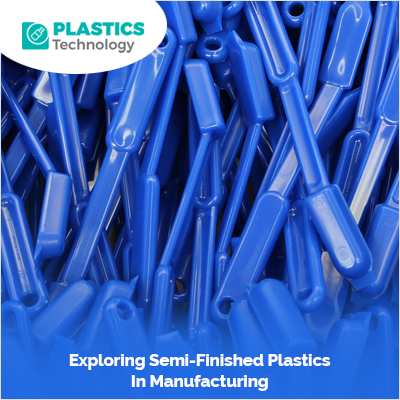Exploring Semi-Finished Plastics in Manufacturing

Are you curious about the role of semi-finished plastics in manufacturing? If so, you're in the right place. In this article, we will explore the world of semi-finished plastics and how they are revolutionizing the manufacturing industry.
Advantages of using semi-finished plastics in manufacturing
Semi-finished plastics, also known as plastic stock shapes, offer numerous advantages that make them an attractive choice for manufacturers. Firstly, these materials exhibit excellent mechanical properties, such as high strength, stiffness, and impact resistance. Unlike traditional metal components, semi-finished plastics can withstand harsh environments, making them suitable for a wide range of applications in various industries.
Moreover, semi-finished plastics are lightweight, which translates to reduced transportation costs and improved fuel efficiency. This characteristic is particularly beneficial in industries like automotive and aerospace, where weight reduction is a critical factor. Additionally, semi-finished plastics are corrosion-resistant, eliminating the need for expensive protective coatings or regular maintenance.
Furthermore, these materials are highly versatile and can be easily shaped and fabricated to meet specific manufacturing requirements. Whether it's creating complex designs or replacing traditional materials, semi-finished plastics offer endless possibilities. Manufacturers can achieve intricate details and precision in their products, resulting in improved aesthetics and functionality.
Types of semi-finished plastics and their properties
Semi-finished plastics come in various forms, each with its unique properties. One common type is plastic sheets, which are available in different thicknesses and sizes. These sheets can be easily cut, machined, or thermoformed to create a wide range of products, from display panels to protective covers.
Another type is plastic rods, which are often used in applications that require high strength and dimensional stability. These rods can be machined or turned to create components such as gears, bearings, and electrical insulators. Plastic tubes, on the other hand, are commonly used in fluid handling systems, electrical conduits, and structural support applications.
Additionally, plastic profiles, such as angles, channels, and T-sections, offer versatility in design and can be used for architectural purposes, framing, and edging. Each type of semi-finished plastic has its own unique set of properties, allowing manufacturers to choose the most suitable material for their specific requirements.
Applications of semi-finished plastics in various industries
The applications of semi-finished plastics span across a wide range of industries. In the automotive industry, these materials are used in the production of interior and exterior components, such as dashboards, bumpers, and trims. Their lightweight nature contributes to fuel efficiency, while their durability ensures long-lasting performance.
In the aerospace industry, semi-finished plastics find applications in aircraft interiors, structural components, and engine parts. Their high strength-to-weight ratio, heat resistance, and excellent electrical properties make them ideal for these demanding applications. Moreover, the ability to create intricate designs and shapes allows for efficient use of space and improved aerodynamics.
The construction industry also benefits from the use of semi-finished plastics. These materials are commonly used in window frames, doors, roofing, and insulation systems. Their resistance to weathering, UV radiation, and chemical exposure makes them a durable and cost-effective choice for construction projects.
Factors to consider when selecting semi-finished plastics for manufacturing
When selecting semi-finished plastics for manufacturing, several factors need to be considered. Firstly, the mechanical properties of the material should align with the intended application. Factors such as strength, impact resistance, and dimensional stability must be evaluated to ensure long-term performance.
Chemical resistance is another crucial consideration, especially in industries where exposure to chemicals or aggressive substances is common. Understanding the compatibility of the material with the surrounding environment is essential to avoid degradation or failure.
Furthermore, the thermal properties of semi-finished plastics should be evaluated. This includes their ability to withstand high temperatures, resist thermal expansion, and maintain dimensional stability over a wide temperature range. These properties are particularly important in industries such as electronics, where heat dissipation is critical.
Processing techniques for semi-finished plastics
Semi-finished plastics can be processed using a variety of techniques, depending on the specific material and desired outcome. One common method is machining, which involves cutting, drilling, milling, or turning the material to achieve the desired shape and dimensions. Machining is often used for creating precise components with tight tolerances.
Thermoforming is another popular technique for shaping semi-finished plastics. This process involves heating the material until it becomes pliable and then forming it using a mold or vacuum. Thermoforming allows for the production of complex shapes and is commonly used in industries such as packaging, automotive, and signage.
In addition to machining and thermoforming, other processing techniques include injection molding, extrusion, and 3D printing. Each technique offers its own set of advantages and is chosen based on factors such as production volume, complexity of the design, and cost considerations.
Common challenges and solutions in working with semi-finished plastics
Working with semi-finished plastics can present certain challenges that manufacturers need to address. One common challenge is the tendency for these materials to warp or deform during processing. This can lead to dimensional inaccuracies and affect the overall quality of the final product. To overcome this challenge, it is important to optimize processing parameters, such as temperature, cooling rates, and mold design.
Another challenge is the potential for surface defects, such as scratches, bubbles, or uneven texture. These defects can impact the aesthetics and functionality of the product. Proper handling, storage, and cleaning of semi-finished plastics can help minimize the occurrence of surface defects.
Additionally, semi-finished plastics can exhibit poor adhesion properties, making it challenging to bond them to other materials. Choosing the appropriate adhesive or employing techniques such as surface treatment or mechanical fastening can improve adhesion and ensure the integrity of the final assembly.
Sustainability and environmental considerations of using semi-finished plastics
In recent years, sustainability and environmental considerations have become increasingly important in the manufacturing industry. Semi-finished plastics offer several advantages in this regard. Firstly, their lightweight nature contributes to reduced energy consumption during transportation, resulting in lower carbon emissions.
Moreover, the durability and longevity of semi-finished plastics reduce the need for frequent replacements, minimizing waste generation. These materials can also be recycled and reused, further reducing their environmental impact. Additionally, advancements in the production of semi-finished plastics have led to the development of bio-based and biodegradable options, providing greener alternatives for manufacturers.
Industry trends and innovations in semi-finished plastics
The world of semi-finished plastics is constantly evolving, with new trends and innovations shaping the industry. One notable trend is the increasing demand for high-performance plastics that offer enhanced mechanical, thermal, and chemical properties. Manufacturers are constantly pushing the boundaries of materials science to develop plastics that can withstand even more demanding applications.
Another trend is the incorporation of additives and reinforcements into semi-finished plastics to enhance their properties. Additives such as UV stabilizers, flame retardants, and lubricants can improve the material's performance and longevity. Reinforcements, such as fibers or nanoparticles, can significantly increase the strength and stiffness of the plastic.
Furthermore, advancements in digital manufacturing technologies, such as 3D printing, are revolutionizing the production of semi-finished plastics. This technology allows for the rapid prototyping and customization of components, reducing lead times and enabling more efficient use of materials.
Conclusion: The future of semi-finished plastics in manufacturing
Semi-finished plastics have become a vital component in the manufacturing industry, offering a wide range of benefits and applications. Their excellent mechanical properties, versatility, and cost-effectiveness make them a preferred choice for various industries, from automotive to aerospace and construction.
As the demand for sustainable and high-performance materials continues to grow, the future of semi-finished plastics looks promising. Ongoing research and development efforts are driving innovations in materials science, leading to the development of even better and more advanced plastics.
In conclusion, semi-finished plastics have revolutionized the manufacturing landscape and will continue to play a crucial role in shaping the future of various industries. By understanding their advantages, properties, and applications, manufacturers can harness the full potential of these materials and unlock endless possibilities in their production processes.



